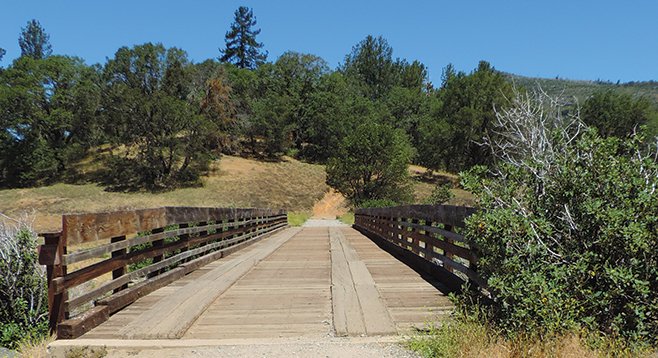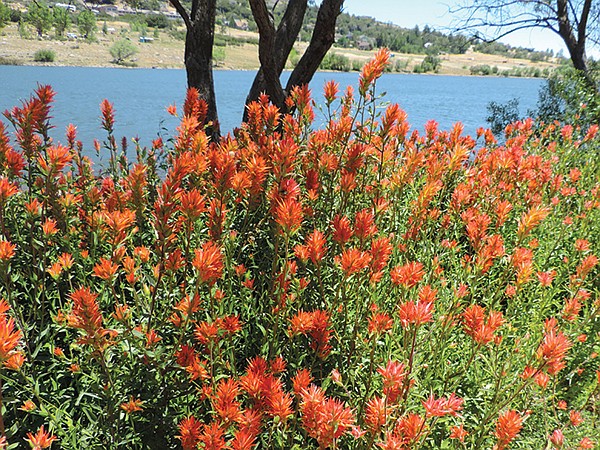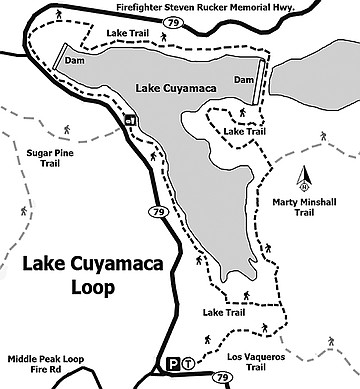 Facebook
Facebook
 X
X
 Instagram
Instagram
 TikTok
TikTok
 Youtube
Youtube

Lake Cuyamaca sits at an elevation of 4600 feet in an oak and pine forest, surrounded on three sides by the 26,000-acre Cuyamaca Rancho State Park. The dam that forms this 110-acre lake is the second oldest in California and was completed in 1888. A long-vanished 33-mile wooden flume transported water to the growing population of San Diego County. Now owned by the Helix Water District, the lake provides a multitude of recreational activities, including fishing, camping, and hiking. The name Cuyamaca is a Spanish corruption of the Kumeyaay phrase “Ekwiiyemak,” which has been translated to mean “behind the clouds” or as “the place where it rains,” alluding to the higher-than-average rainfall experienced here as compared to the dryer coastal regions of the county.

This area has a variety of large mammals to be on the lookout for, including mule deer, mountain lion, bobcat, and coyote; smaller mammals include ground squirrels, voles, pocket mice, and bats. The western gray squirrel, once plentiful, has been on the decline in recent years but the cause remains a mystery. Over 220 species of birds have been reported here. Red-winged blackbirds, named for the red chevron seen on their wings in flight, can usually be found in the reeds along the edge of the lake. Shore birds, such as terns, great and snowy egrets, and great blue herons, can be observed patrolling the lake for a fish dinner. While not native to the area, there is a thriving population of wild turkeys, introduced in 1994, that are a common sight in the meadows or crossing the trail. Other bird species likely to be seen are acorn woodpeckers, western bluebirds, and northern flickers.
Begin the hike at the Trout Pond Trailhead, noting that there is actually no Trout Pond Trail, but rather three trails (Minshall, Los Vaqueros, and Los Caballos) that begin at or near this location. When the lake’s level is as low as it is, a loop completely around the lake is feasible and rewarding.

Start on the Marty Minshall/Los Vaqueros Trail that skirts to the south of a large meadow at the edge of the lake. Much of this meadow will be submerged in wetter years. This is also the northern boundary of the Cuyamaca Meadows Natural Preserve, which was established to protect a number of sensitive plant species, including Lake Cuyamaca downingia, Parish’s meadowfoam, and Cuyamaca larkspur. Keep straight on the Minshall Trail, as it intersects with the Los Caballos Trail (heading toward the Los Caballos Horse Camp) at about 0.4 mile. At just under 1 mile there will be a trail marker on the right for the Stonewall Mine. In a wet year this would make a fine alternative hike over to the mine. For now, however, look to the left. Look for a narrow opening through the fence that leads toward the lake and onto the Lake Trail. Cross over a bridge and begin the loop around the lake. Turn right after the bridge for a slightly shorter walk or turn left for an additional 0.4 mile to walk under the shade of mature oak and pine trees. Keep alert for an imposing wooden sculpture of a bear (a must photo op). After crossing over the eastern boundary of the lake, the trail will follow along the northern shore and past Chambers Park and Lone Pine Camp. As the restricted area of the dam is approached, turn right and follow the trail north and then west to SR-79. Walk about 300 yards beside the road until the dam is passed, and then drop down to the shore to continue the hike. This is a good section of the lake to pause for a snack or light lunch before continuing on to the east and passing through the meadow once again to arrive back at the Minshall Trail. Retrace your route for 0.5 mile to return to your vehicle at the trailhead.


Lake Cuyamaca sits at an elevation of 4600 feet in an oak and pine forest, surrounded on three sides by the 26,000-acre Cuyamaca Rancho State Park. The dam that forms this 110-acre lake is the second oldest in California and was completed in 1888. A long-vanished 33-mile wooden flume transported water to the growing population of San Diego County. Now owned by the Helix Water District, the lake provides a multitude of recreational activities, including fishing, camping, and hiking. The name Cuyamaca is a Spanish corruption of the Kumeyaay phrase “Ekwiiyemak,” which has been translated to mean “behind the clouds” or as “the place where it rains,” alluding to the higher-than-average rainfall experienced here as compared to the dryer coastal regions of the county.

This area has a variety of large mammals to be on the lookout for, including mule deer, mountain lion, bobcat, and coyote; smaller mammals include ground squirrels, voles, pocket mice, and bats. The western gray squirrel, once plentiful, has been on the decline in recent years but the cause remains a mystery. Over 220 species of birds have been reported here. Red-winged blackbirds, named for the red chevron seen on their wings in flight, can usually be found in the reeds along the edge of the lake. Shore birds, such as terns, great and snowy egrets, and great blue herons, can be observed patrolling the lake for a fish dinner. While not native to the area, there is a thriving population of wild turkeys, introduced in 1994, that are a common sight in the meadows or crossing the trail. Other bird species likely to be seen are acorn woodpeckers, western bluebirds, and northern flickers.
Begin the hike at the Trout Pond Trailhead, noting that there is actually no Trout Pond Trail, but rather three trails (Minshall, Los Vaqueros, and Los Caballos) that begin at or near this location. When the lake’s level is as low as it is, a loop completely around the lake is feasible and rewarding.

Start on the Marty Minshall/Los Vaqueros Trail that skirts to the south of a large meadow at the edge of the lake. Much of this meadow will be submerged in wetter years. This is also the northern boundary of the Cuyamaca Meadows Natural Preserve, which was established to protect a number of sensitive plant species, including Lake Cuyamaca downingia, Parish’s meadowfoam, and Cuyamaca larkspur. Keep straight on the Minshall Trail, as it intersects with the Los Caballos Trail (heading toward the Los Caballos Horse Camp) at about 0.4 mile. At just under 1 mile there will be a trail marker on the right for the Stonewall Mine. In a wet year this would make a fine alternative hike over to the mine. For now, however, look to the left. Look for a narrow opening through the fence that leads toward the lake and onto the Lake Trail. Cross over a bridge and begin the loop around the lake. Turn right after the bridge for a slightly shorter walk or turn left for an additional 0.4 mile to walk under the shade of mature oak and pine trees. Keep alert for an imposing wooden sculpture of a bear (a must photo op). After crossing over the eastern boundary of the lake, the trail will follow along the northern shore and past Chambers Park and Lone Pine Camp. As the restricted area of the dam is approached, turn right and follow the trail north and then west to SR-79. Walk about 300 yards beside the road until the dam is passed, and then drop down to the shore to continue the hike. This is a good section of the lake to pause for a snack or light lunch before continuing on to the east and passing through the meadow once again to arrive back at the Minshall Trail. Retrace your route for 0.5 mile to return to your vehicle at the trailhead.